This site was created specifically for people from Canada, for quick acquaintance with the gambling industry online. In today's article, you can know all about Top 10 Tips for Online Poker Bankroll Management in Canada. Our Canadian visitors have asked us so many times to write the review of "Top Tips for Building Poker Bankroll Management Charts, Top 10 Tips for Online Poker Bankroll Management in Canada" because of high interest in this topic. Well, the thorough investigation by our gambling expert had been already finished and we have collected here all useful information about Top 10 Tips for Online Poker Bankroll Management in Canada in one review. You may read it now!
Top 10 Tips for Online Poker Bankroll Management in Canada
Here is a baseline chart referencing the appropriate BRM for playing various tournaments sizes: Some players advocate playing a more aggressive approach. This method entails keeping a smaller number of required buy-ins. Then you would and takeshots at the next higher stake as soon as possible.
Top Tips for Building Poker Bankroll Management Charts
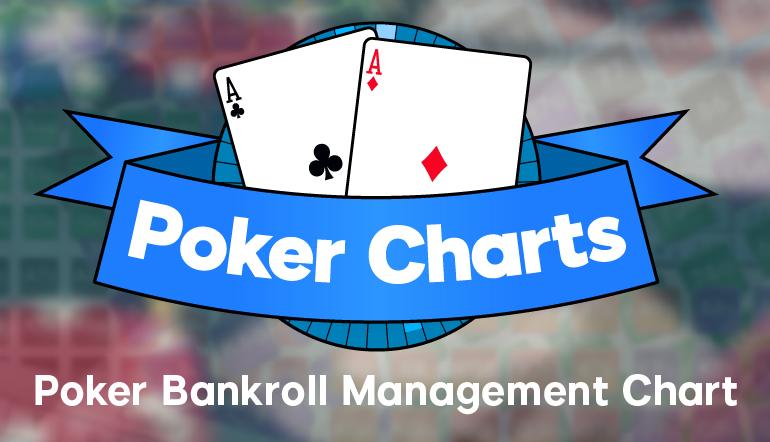
Matthew Cluff
Poker Bankroll Management (BRM) is one of the key pillars of being a successful poker player. It involves setting aside money you have designated for playing poker.
Poker has a high degrees of variance. So, knowing and following proper BRM is imperative.
This process promotes a healthy bankroll as you strive to improve your game and move up stakes.
There are a couple of different philosophies on proper bankroll management. The truth is that there is no one-size-fits-all solution.
Some players advocate playing a more aggressive approach. This method entails keeping a smaller number of required buy-ins. Then you would and takeshots at the next higher stake as soon as possible.
Others advocate exercising ultimate caution to minimise the potential to ever go broke.
In this article, we will cover the ins and outs of proper Bankroll Management–
- Understanding Bankroll Buy-In Management Charts
- Reassessing Bankroll Management in Charts
- Shot Taking: Moving Up Stakes
- Shot Taking: A Psychological Perspective
- How Much Do You Need To Go Pro?
- BRM: Tournament Bankroll Requirements
- In Conclusion – Poker Bankroll Management
Understanding Bankroll Buy-In Management Charts
There should be a hybrid of both theories. They can be utilized at different times as one grows their bankroll (i.e. for the first time).
Part of the reason for this ties into something that Jonathan Little says -
Your BRM guidelines should be dependent on your win rate for the game that you’re playing.
Take a look at the following chart:
NOTE: 3% chance of going broke using the guidelines outlined below:
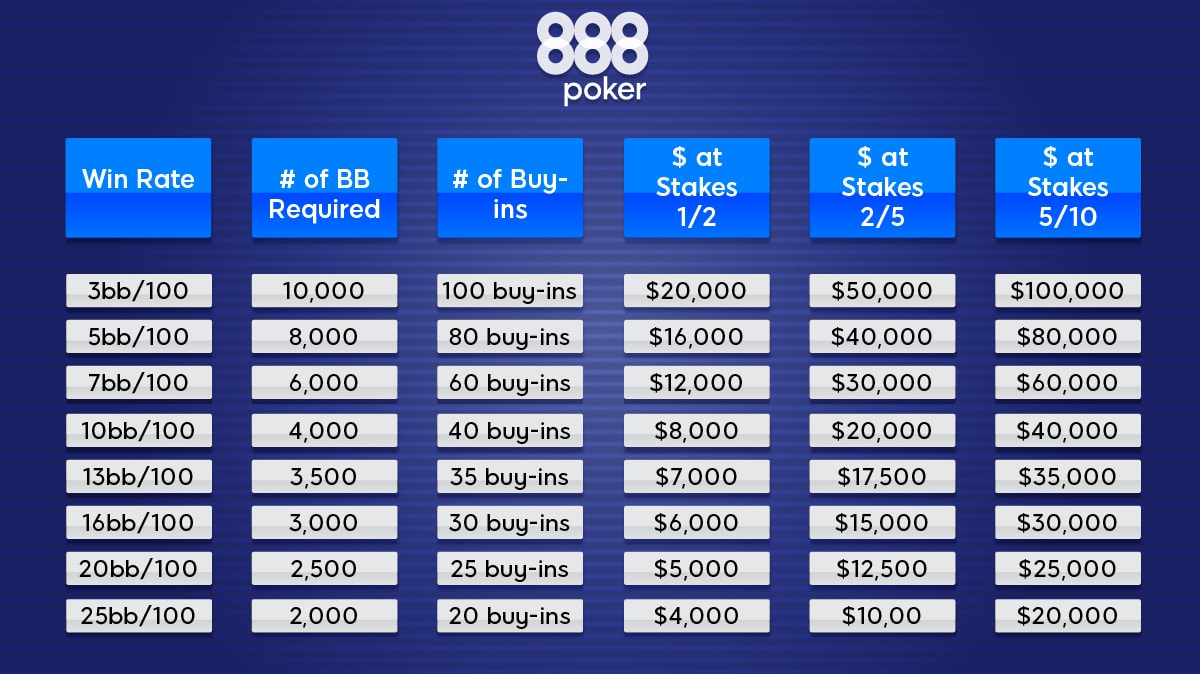
Bankroll Management guidelines chart
Typically, there is a more significant number of bad players at lower stakes games. As such, a solid reg will usually achieve a better bb/100 winrate at lower stakes (maybe 20bb/100 at 2NL).
This rate is greater when compared to medium and higher stakes (such as 3bb/100 at 200NL).
Let’s relate this info to the chart above. It becomes evident that a solid winning player will often require less strict BRM guidelines for lower stakes games.
At higher stakes games they need more because of their corresponding bb/100 win rates.
Reassessing Bankroll Management in Charts
Of course, a win rate can often take from 25,000 to 100,000 hands (minimum) to get an accurate determination/result. As you progress through this sample size, it’s crucial always to assess and re-assess this figure of yours.
Then you can relate it to how many buy-ins you should have to, comfortably, stay at the stake you’re playing.
As an example, a poker hobbyist, who ran hot for three sessions at $1/$2 live, boasted -
“Thanks to , I now have a win rate of $100/hr at 200NL after three sessions!”
Well, the truth isthis win rate might be valid for three sessions worth of poker. But it’s going to be almost impossible to maintain this rate over a 25k to 100k hand sample size. (Even the world’s best players wouldn’t be able to achieve win rates like that over enough hands.)
There are appropriate times when you may want to implore either safe or aggressive BRM.
Here is a chart outlining the minimum money requirements (in dollars) a particular stake:
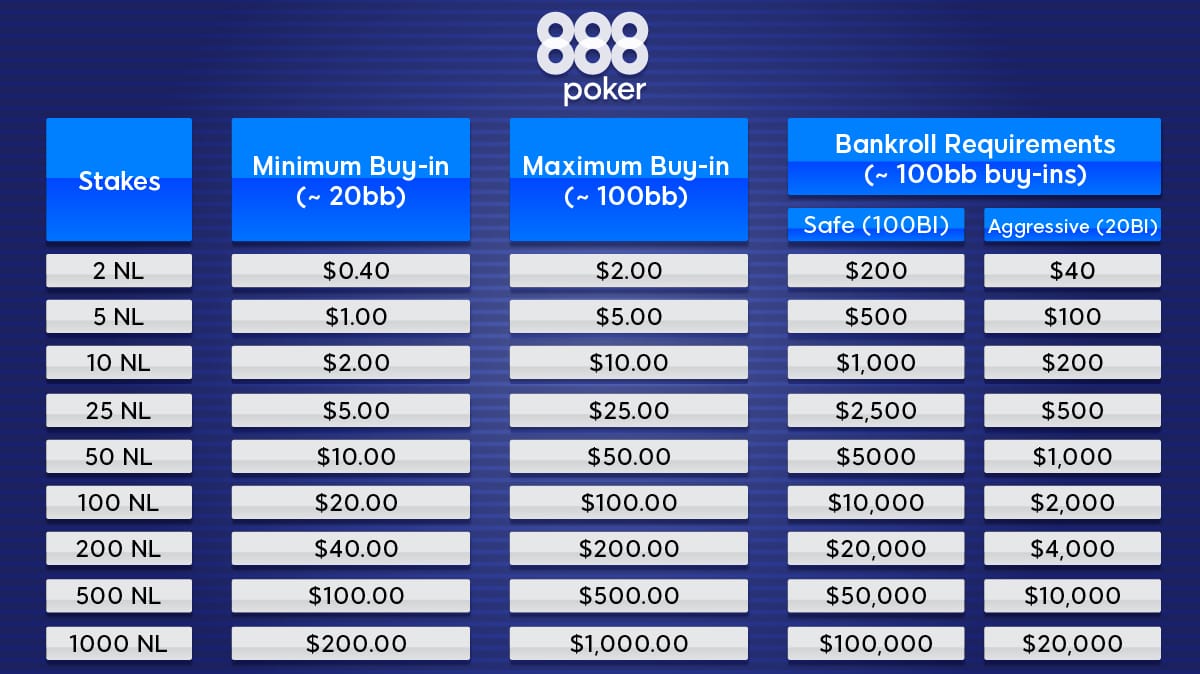
Minimum bankroll money requirements (in dollars)
Shot Taking: Moving Up Stakes
Practising “shot taking” is an essential part of moving up stakes. Most stakes are at least double the stake level immediately below. BRM guidelines dictate you should have 100 buy-ins for your stake
So, you’d need to have 200 to 250 buy-ins of your current stake to start playing the next one.
This situation would entail an extremely long grind at each stake. It is not at all practical from a time standpoint - especially if you’re already a winning player.
Players usually practise “shot taking” when moving up the ladder of stakes. They’ll often not have the recommended number of buy-ins when attempting to move up in stakes.
This fact might mean having as little as $9,000 from live $1/$2 profits before taking a shot at $2/$5 (18 buy-ins).
In this example, you could take three buy-in shots at 500NL before you’d have to move back down.
Note that the above example uses a 15 x buy-in minimum for shot-taking. (This rate is a standard, aggressive recommendation).
The lowest buy-ins one should EVER shot take with under any circumstance would be 11. (This number would leave one buy-in as a buffer. But you should never dip below 10 full buy-ins.)
Shot Taking: A Psychological Perspective
Some poker playerstake shots, purely based on psychological factors.
Let’s say that you’re hovering around a $6,000 roll. You usually, play $1/$2 live and want to take a shot at $2/$5 soon.
You put in a session at 200NL and build up a $700 stack ($500 profit) within a few hours.
Psychologically, this is a great time to take a shot at 500NL. If you lose your buy-in, you’ll still walk away at the end of the day even.
Players may also want to have 1.5 to 3 buy-ins set aside for their shot taking. If they lose a bit of their stack, they can still play a 100bb game without being a short stack.
How Much Do You Need To Go Pro?
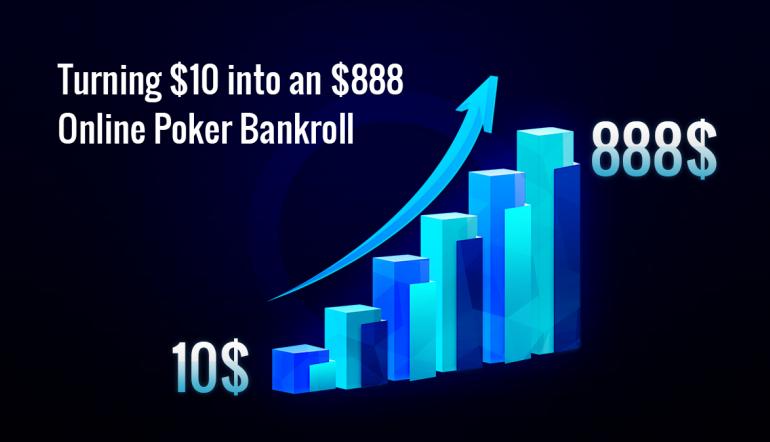
You can undoubtedly make a living grinding micro or low stakes games. But your corresponding win rate would require extremely long hours. (This rate also depends on where you live and what your typical annual expenses.)
As such, a recommended goal is to make it to 500NL in live poker rooms.
At that level, you should be able to –
- Pay your bills live
- Live comfortably
- Prove yourself to be a winning player
For online pros, it could be as low as 100NL. (Being able to play more hands per hour and multi-table will help compensate for a lower bb/100 winrate.)
Once you go 100% pro, it’s imperative that you nit-up your Bankroll Management (BRM). There is no side job to support you if things take a turn for the worse in poker.
So, you must protect your assets. Play a safer BRM than if you had other guaranteed income streams in the mix.
The recommended bankroll you’d need to go pro in a live setting is –
In the above scenario, you should have between $60k and $65k before “going pro.”
BRM: Tournament Bankroll Requirements
Up until now, we’ve talked about the BRM needed for cash games?
What if you’re a tournament player, though?
Often, players will use an AVERAGE BUY-IN (ABI) rule to calculate which games they should play. For example, say their BRM requires 100 buy-ins.
With a $10,000 bankroll, they can only play $215 tournaments if they mix some lower buy-in, as well.
Tournaments carry unique BRM guidelines, as well.
The variance you will experience will much depend on factors such as:
- How many players there are in the tournament (how big the tournament field is).
- What your ROI is for such tournaments (over a decent sample size).
- How high the rake is? (Many live, small-buy-in “daily tournaments are not beatable over the long-term. The rake is too high relative to the prize pool. When just starting out, strive to find tournaments that have less than 13% rake.)
- The structure of the tournament: turbos and hyper-turbos will carry more variance. With the faster blind levels, you’ll be all-in more often and sooner.
Here is a baseline chart referencing the appropriate BRM for playing various tournaments sizes:
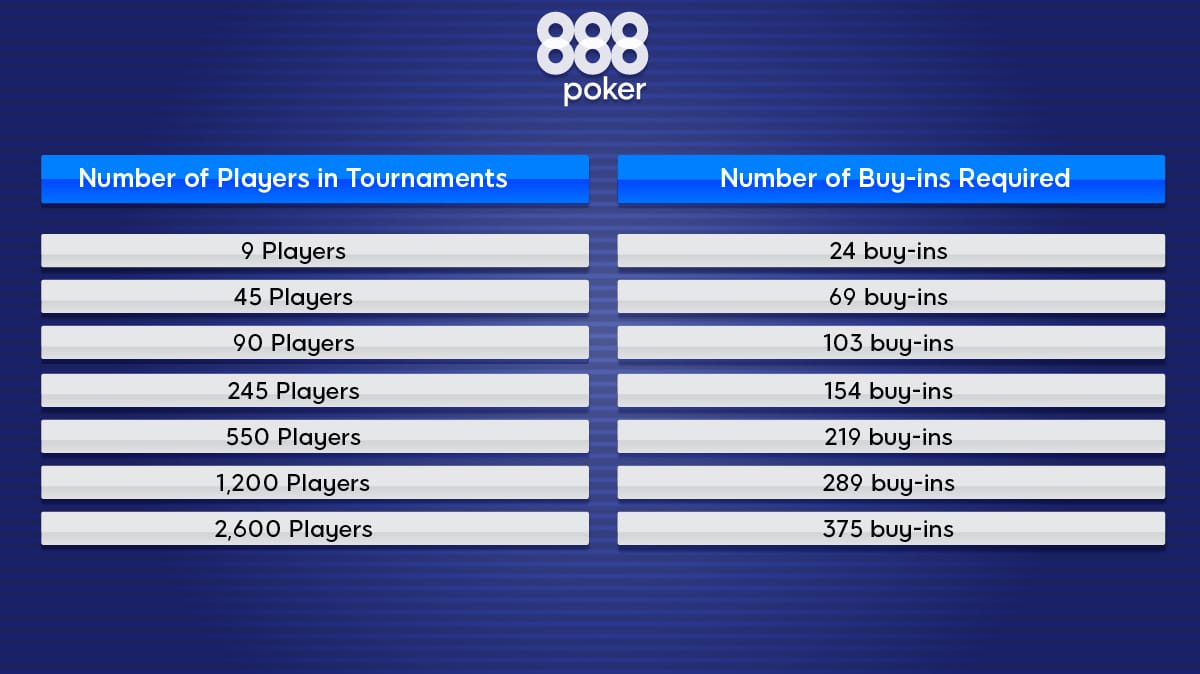
Appropriate BRM for playing tournaments of various field sizes
When you dip about 20% below the required bankroll, it is wise to start lowering your average buy-in (ABI)
Try mixing in smaller games where you have a more significant win rate.
In Conclusion – Poker Bankroll Management
As you can see, there are many aspects to keeping a healthy bankroll and moving up stakes.
Here are FIVE key takeaways -
- Always keep in mind what your win rate is in the games you play. Be sure to be flexible with your BRM and adjust accordingly.
- Never hesitate to move down stakes, if necessary.
- Downswings are a normal part of the game. But they can cause substantial psychological effects, causing you play off you game.
- Being properly rolled should never be a worry when you’re at the table. Ifyou’re playing higher than you should, you won’t be able to play you’re A-game.
- If the dollar amount at the table seems too big, then you’re playing at too high a stake.
Keep these tips in mind as you build up your roll, and good luck at the felts!


Top 7 Tips for Creating and Maintaining Your Poker Face!

Are You Playing any of the Top 7 Worst Starting Hands in Poker?

Striking that Delicate Balance with OOP Drawing Hands
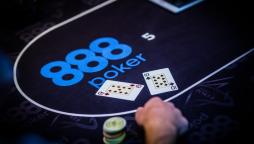
Open-Face Chinese Poker Is the New Popular Poker Kid on the Block!

Quack! Quack! Learn How to Turn Pocket Deuces into a High-Value Hand!

Poker Cheat Sheet – Shortcuts and Inside Tips for Beginners

How to Manage Your Online Poker Bankroll By Chris Moorman

Running Bad in Poker - Vivi Saliba’s Top 4 Poker Tips

Poker Hand Strength – When To Fold And When To Hold
Learn to Turn Your Pocket Aces into Consistent Winners!

Top 7 Tips for Creating and Maintaining Your Poker Face!

Are You Playing any of the Top 7 Worst Starting Hands in Poker?
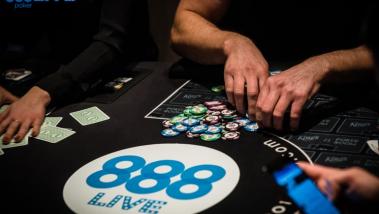
Striking that Delicate Balance with Your Out-of-Position Drawing Hands

Open-Face Chinese Poker Is the New Popular Poker Kid on the Block!
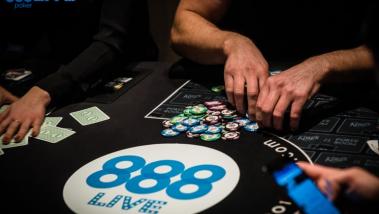
Quack! Quack! Learn How to Turn Pocket Deuces into a High-Value Hand!
Copyright 2021, the 888 Group. All rights reserved.
888 Holdings plc is listed on the London Stock Exchange.
Virtual Global Digital Services Limited is licensed and regulated to offer online gaming services under the laws of Gibraltar (Remote Gaming License Numbers 112 and 113) and makes no representation as to legality of such services in other jurisdictions.
Our services in the UK are operated by 888 UK Limited, a company incorporated in Gibraltar. 888 UK Limited is licensed and regulated in Great Britain by the Gambling Commission under the account number 39028.
Our services in European Single Market member states (except for states in which our services are provided under a local license) are operated by Virtual Digital Services Limited, a company incorporated in Malta which is part of the European Union.
Virtual Digital Services Limited operates under the auspices of a gaming license provided under the laws of Malta - MGA/CRP/543/2018 issued on the 11/10/2019.
Our betting products are operated in Ireland by 888 (Ireland) Limited, a company incorporated in Malta, which is licensed and regulated by Ireland's Revenue Commissioners.
The address of our Gibraltar based companies is: 601-701 Europort, Gibraltar.
The address of our Malta based companies is: Level G, Quantum House, 75, Abate Rigord St., Ta’ Xbiex, XBX 1120, Malta
Gambling can be addictive, please play responsibly. For more information on support tools, please visit our Responsible Gambling page
A Comprehensive Guide to Bankroll Management

When you first think about online poker, you probably instantly have thoughts about audacious bluffs, big bets, and scooping huge piles of chips towards you after a successful hand. What most players don't realise is this though: of all the different tactics, strategies and ideas in online poker, the most vital is bankroll management.
But what exactly is bankroll management? Well, for starters, it has absolutely nothing to do with how you play the actual game. Instead, it's how you manage the money in your account, to ensure that you always have funds available to play with, even if you do happen to go through a lean spell on the tables.
So, if you're new to the game of poker, or if you're finding that you keep having to top up your account with more and more money on a regular basis, this is undoubtedly the page for you. Once you understand bankroll management, you should then see your long-term success at the poker table rise!

In regards to moving up in stakes, the CardsChat Bankroll Management strategy article is a good resource. Bankroll management is individual - people in different circumstances and with different goals will have different bankrolls - but this article provides really good rules of thumb that can be followed by beginner and intermediate players alike. The rules are simple, which makes following them easier.
PCardsChat forum member since 2008, has over $200k in live tournament winnings

Work and save some $ and put it aside to gamble with. Don't gamble with what you can't afford to lose. Always stings.
CardsChat forum member since 2012, has $300k in live tournament winnings

Bankroll Management Explained
In the simplest terms, your poker bankroll is the amount of money you have set aside for poker. This doesn't include money you have in your bank account for bills and your mortgage, nor does it include any money you're expecting to get in the future. It is purely the money you are prepared to devote solely to poker playing. This is why, when you look to build a bankroll, you should start by deciding how much you are prepared to risk. For some, it might be $10, while for others it could be $1000. Regardless of how much it is, it can still be used as a starting point for building your poker funds.

Some people make the mistake of thinking that their bankroll is simply the money in their online poker account, but this is not the case. You might, for example, decide that you have a $100 limit on your bankroll, but then only decide to deposit $50, leaving the other $50 safely stashed away in case you need to reload. Where your money actually is, is irrelevant - knowing how much you're prepared to spend in total is vital.
Bonuses and Your Bankroll

If you are savvy when choosing poker sites to play at, it is possible to increase your bankroll drastically when you make your first deposit. This is because the majority of online poker sites offer juicy welcome bonuses, which can double - or sometimes even triple - the amount of cash you deposit. You'll be able to find the very best online poker bonuses around here on this site, simply by reading through the reviews of different poker sites.
There's one thing about bonuses that is really important to remember though: always ensure that you input the code if required. If you don't you will miss out on all that extra cash, and won't be able to claim it at a later date. Also, remember this: while bonuses can be a great way to build your bankroll at the start, they will nearly always have a rollover requirement attached to them. This means that you can play with the money, but you won't be able to withdraw it - or any winnings made using it - until you have gambled it a certain number of times.
The first thing to really remember about building a bankroll is this: use bonuses wisely.
Don't forget that there's nothing wrong with splitting your bankroll over two or more different online poker sites, which will mean that you'll be able to take advantage of more welcome bonus offers, and therefore earn more money in the process!

The Ideal Starting Bankroll
Many people wonder what the ideal starting bankroll should be, however there is no real answer to this question. The reason for this is simple: everyone has their own limits, and therefore some will be able to devote more money to poker than others. The important thing to remember is this though: while poker is a game of skill, there is a chance that you will lose. Therefore, you should never deposit more money at a site than you can afford to lose. Hopefully though, if you play well and follow the basics of bankroll management, your bankroll will only grow and you'll never have to deposit any more money at your chosen online poker site again.
How Much to Risk
After you have determined how much you can afford to deposit each month, the first order is to set limits on what stakes you will play.
Cash game

at least 20 buy-ins
(some players prefer as many as 40-50)
Example: .05-.10NL
A good rule of thumb for cash players is to have at least 20 buy-ins (some players prefer as many as 40-50). That means if you are going to play .05/.10NL and the minimum buy-in for the table is $4, then you would ideally have at least $80 in your account. If you're the kind of player who wants to buy in for the maximum, say $10, then you would want to have $200 in your account.
You must also set limits for individual sessions. Knowing when to quit is a tough decision for cash game players. The decision can be equally difficult when you are having a winning session or a losing session. Many players confuse a "hot streak" with great play. They'll get up 4-5 times their buy-in, convince themselves that their run of monster hands and suckouts is actual skill and keep playing. Three orbits later, they've frittered away some, if not all, of their potential profit simply because they didn't know when to quit.
Set a goal for yourself. It's also a good idea to set a loss limit, too. Examples:

to win twice the buy-in
Once you achieve that goal, cash out and turn the computer off. Hot streaks are going to end some time.

limit of no more than two buy-ins per session
Once you've lost that second buy-in, call it a night and come back the next day.

restrict yourself to 2% of your bankroll for any buy-in
Tournaments
For multi-table tournaments, try to restrict yourself to 2 percent of your bankroll for any one buy-in. If you have $500 in your account, look for tournaments that are $10 or less. The same principle can be used for sit-n-goes.
You need to make sure your buy-in total includes rebuys or add-ons. If you play a tourney that offers re-buys and add-ons, add up the cost of the initial buy-in, one rebuy and one add-on and then make sure you're still under the 5 percent mark. As you'll see later though, it is generally a good idea to avoid rebuys and add-ons when playing in tournaments.

Building a Bankroll
So, now you have your initial bankroll ready to go, and you're itching to start making some money at the poker tables. Bankroll management isn't just a case of starting with the right amount of money though - it's also the case of making sure you never exceed your limits while playing, even if you've suddenly managed to turn $100 into $1000. So, what rules should you follow when trying to increase your bankroll in the safest and most sensible way? Well, it depends on a few factors, and they are illustrated below.

1. The Stakes
Obviously, playing higher stakes will require a larger bankroll than grinding lower stakes of the same game type. However, this effect is not always linear, as the possible variance in moving from 50NL to 200NL may be such that the player requires more than four times the bankroll from his days of grinding 50NL.

2. The Game Type
In general, playing tournaments as opposed to cash games will be higher variance and require a larger bankroll even at similar stakes. Lower variance game types will require lower bankrolls as compared to their faster-paced counterparts. Extremely high variance formats, such as super-turbo tournaments, will require you to have a higher bankroll (in terms of number of buy-ins).

3. The Rate of Winning
For tournament players, this figure refers to the player's return on investment (ROI) that they can expect from the tournaments they currently play. For cash games, this figure is the player's win rate in big blinds per 100 hands played. Regardless of whether one is a tournament or cash game player, a large sample size of hands is necessary to accurately assess the rate of winning. Many people overestimate this number based on running unsustainably well over too small of a sample of hands. For those that are unsure as to the accuracy of their win rate, it is suggested that they proceed with caution and research.

4. The Comfort Level
This key aspect is primarily influenced by two key components: life roll (or the person's other available cash and income streams) and the mental composure of the player. Mental composure refers to the individual tendencies of the player that will often converge with optimal bankroll management decisions unique to each individual. Some players may feel that having a bankroll that is three times the suggested standard bankroll for their situation enables them to play better poker. Others may conclude that having an overly-large bankroll contributes to them playing sloppy poker. If having a larger than normal bankroll helps a player to perform with better clarity, then this can be a component that almost supersedes the other guidelines in terms of arriving at an ideal bankroll figure.
Examples of Bankroll Building
Everyone is different, and everyone will go about building their bankroll in a slightly different way - as mentioned above, there are various factors that can influence the exact path you choose to take. To give you an idea about how to build a bankroll in different situations, we've come up with three examples, which you can read below:

Player A
Player A plays live 200 NL ($1/$2 no limit hold'em), and has maintained an hourly rate of $12 an hour after playing for 60 hours a week for the last year. If the player saw 25 hands an hour, this would mean that his sample size was a bit under 80,000 hands.
When he began playing, he started online at lower stakes. During his transition to live, he felt that he was uncomfortable and under-rolled when he started with 10 buy-ins, and became worried that he was playing too tightly when he experienced a downswing. Now that he has built his bankroll up to $5,000, he is wondering if it is time to make the jump to $2/$5.
Being as the player experienced stress when playing with a shorter roll before, and the fact that he can likely expect for his win rate to decrease, it would not be advisable to move up in stakes yet. In this player's case, grinding $1/$2 until he has well over two and a half times the bankroll for 200NL would be advisable. Additionally, he could alternate sessions at both stakes to lower his average buy-in and increase his comfort level at the higher-stakes.
live 200 NL
hourly rate of $12
after playing for 60 hours a week
bankroll up to $5,000
jump to $2/$5

Player B
Player B plays mid-stakes multi-table tournaments online. He has played over 25,000 tournaments and has maintained a 25% average return on investment. In the past, he has taken a few isolated shots in high-stakes tournaments. Although none of them have enabled him to move to high-stakes tournaments for any length of time, the player was not put under any undue stress and he came away from the experience happy with how he played.
He maintains a bankroll of 300 times his average buy-in, which at times he feels is too conservative, and may be holding him back from reaching the high-stakes tournaments he wishes to play as quickly as possible. This player may be a better candidate for taking a more aggressive strategy with building his bankroll, so long as he is comfortable with having to play lower if increased shot-taking doesn't pan out. Additionally, he is likely in an easier position than Player A to find a stake should things go poorly. This player could consider lowering his average buy-in bankroll requirement to 250, and using the extra 50 buy-ins towards a fewer number of carefully planned shots.
over 25,000 tournaments
25% average return on investment
lowering average buy-in to 250
extra 50 buy-ins to plan shots carefully

Player C
Player C plays low stakes super turbo sit and goes, and is hoping to transition to normal speed sit and goes. He has played very few normal speed sit and goes, but over 30,000 super turbos with a 5% return on investment. In general, a lower expected ROI for a player is likely to be higher variance, and for that reason he maintains a very conservative 400 buy-ins for grinding the super turbos. He feels that sometimes he gets bored playing the super turbos, and is ready to play a new game type. He also feels that he'll have a higher ROI in the lower variance format of normal speed sit and goes, and that will enable him to be less conservative with his bankroll, and thus progress in stakes more rapidly.
One of the benefits of maintaining a conservative bankroll is that it enables a player to potentially take shots, but the problem with Player C's analysis is that he does not know what his expectation is in the new game type he wishes to play. Grinding the game at which he is a proven winner such that he could afford to get a coach for the new game type could be a good option. Alternatively, if he has studied the nuances of the new game extensively, he could devote a separate amount towards that game, ideally starting out at the micro-stakes in order to minimize risk. The important thing is that Player C recognizes that how he can expect to perform in the new game type is mostly independent to how he did in the super turbos. While of course there will be some cross over in skills, to assume that a proven winner in a game type can switch to a different game and win more is to disregard an accurate assessment of one's own win rate.
30,000 super turbos
5% return on investment
ready to play a new game type
Managing Your Expectations

Perhaps the biggest issue people have with bankroll management is their own expectations. Many people join a poker site and expect to turn their $10 into $10,000 overnight, simply by entering a $10 multi-table tournament and beating the rest of the field. While it would be wrong to say that this has never happened, 99.99% of the time it ends with the bankroll being lost and the player having to reload their account again.
This is where expectation management is important. Instead of setting unrealistic goals, you need to move forward with small steps. So, you should be happy if you manage to turn that $10 into $11 on your first day. Moving ahead to higher stakes, you should be glad if you manage to turn your $1000 bankroll in $1050 after a session. Of course, there will be days when you surpass your goals, but these should be taken as the exception, rather than the rule.
People expect to turn their $10 into $10,000 overnight.
Be happy if you manage to turn that $10 into $11 on your first day
Be happy if you manage to turn that $1000 into $1050 on your first day
Also, you will lose money at some point. Losing is part of poker, and it happens to everyone from beginners through to players like Daniel Negreanu and Phil Ivey. You have to learn that losing some of your money isn't a disaster and, as mentioned earlier, you should stop playing when you have lost a certain amount. By doing so, you'll prevent yourself from going on tilt (getting so angry that you start risking more and more money on risky plays) and will also ensure that you've got money for tomorrow - and tomorrow could be the day that you win back your losses, plus more!
So, the golden rule here is this: don't expect too much of your yourself, and don't get downhearted if you have a bad day. Even the best players in the world don't double their bankroll every time they sit down at a poker table!
How to Avoid Losing Your Bankroll
You will occasionally lose - as already mentioned, that's simply part of the game. But there are a few things to remember if you want to limit your losses as much as possible. You'll find them listed below.

Avoid re-buy tournaments
Re-buy tournaments are generally best avoided. They lure you in with a small buy-in and a disproportionately large prize pool ($2 buy-in for a $1,500 tournament). This initial buy-in is misleading though. These tourneys generally feature smaller starting stacks (say 1,000 or 1,500 chips). Throw in hyper-aggressive play from players who are trying to get double-ups as quickly as possible and a massive add-on (10,000 chips for $2) that entices you to keep re-buying, and you've got a recipe for disaster. The next thing you know, you're on your fifth re-buy and you then decide to stump up another $2 on the add-on. The cheap, $2 tourney has turned into a $14 buy-in. Even if you make the money, you'll have to get pretty close to the final table just to recoup your investment. Beginning players should avoid rebuys like the plague.

Watch out for late registration
Avoid tournaments with long registration windows (anything more than one hour). Some sites offer late registration for as long as five hours on some of their bigger tournaments, which means you're going to have to play at least six or seven hours just to get a min-cash. If you're a relatively inexperienced player, chances are your game is not to the level needed to be able to last as long as seven hours in a large multi-table tournament.

Get there early
Register at the beginning of the tournament so you get the maximum value for your buy-in. A tournament with an initial starting stack of 3,000 and an initial big blind of 20 gives you 150 big blinds to start with. If you wait and register when the big blind is up to 60, you're starting out with 50 big blinds. Give yourself the best possible chance to play your normal game.

Forget the auto-top up option
For cash players, one sure way to lose more than you intended during a session is to take advantage of the auto top-up feature. The auto top-up always keeps your stack at the level you bought in for. So, if you are on a $.05/$.10 table and buy-in for $10, any time your balance dips below $10, the site will top you up to $10 again. Expert players will tell you to enable this feature. They believe that you should always have your max buy-in at your disposal so when you get the opportunity for the double-up, you are maximizing your profits.
That might work for experts, but for new and recreational players, the auto top-up can have disastrous effects. It keeps you from knowing how much you have lost in a session. For a player with a small bankroll, this is critical information. You need to know if you've already lost $6 of your original $10 buy-in. Ignoring how much you've lost in a session will ensure your bankroll disappears quickly.
Conclusion

There's no other game in the world quite like poker. Luck certainly plays its part in the game, but there are so many other nuances that can be used to gain the advantage and help you to win money when you play. Bankroll management, while not one of the most glamorous parts of the game, is certainly one of the most important things to understand though. Keep an eye on your bankroll management and you should find yourself having to deposit less, but allow your focus to drop for a while, and you could end up reloading your account over and over again.
Regardless of whether you're planning to deposit $10, $100 or $10,000, bankroll management is something you should certainly think about, and the hints, tips and explanations found in the article above should give you everything you need to not only make sense of bankroll management, but to use it in a way that benefits your entire online poker experience. So, why not take a look at your current bankroll, and devise a bankroll strategy before you next sit down for a quick game?
Six Tips for Managing Your Poker Bankroll
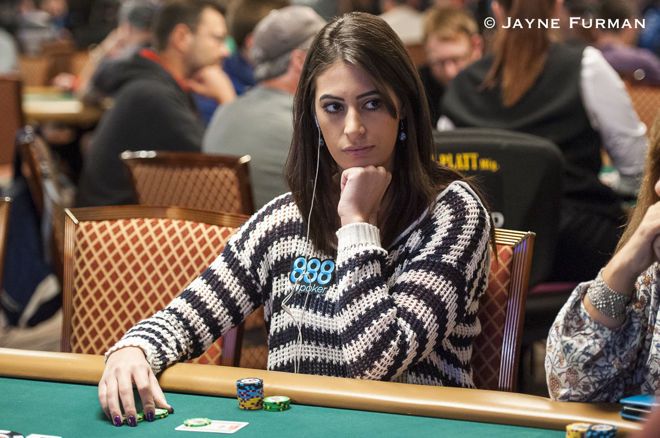
Everyone knows how essential it is to practice smart bankroll management in order to be a successful poker player. Even though this might seem simple to do, many players — even very good ones — find themselves constantly struggling with their finances for long periods during their careers.
Being smart with how you spend and/or invest your money not only can help you stay in action and even move up in stakes, but also can ensure you keep the money you have already earned playing poker.
The fact is, even some of the most brilliant poker players have experienced the consequences of poor bankroll management — even Poker Hall of Famers.
Stu Ungar, for example, by some accounts won over 30 million dollars in poker, yet thanks to other life leaks still went broke several times. On his website Scotty Nguyen talks about how he "has lost and amassed his bankroll numerous times in poker." And Mike Sexton has lost his fair share, too, as he talks about with Jonathan Little in their recent conversation on the topic of "How to Hold Onto Your Money."
Here are six strategies that I have found useful when it comes to bankroll management, an important "skill" to develop for poker players.
1. Separate your personal and poker finances
You should treat poker as a business. The money you use to play poker should be treated like "company money." It doesn't matter how much you've separated out with which to play, you should avoid spending your poker bankroll otherwise. You shouldn't be counting on this money to pay your bills. Therefore be smart about just how much you can reasonably commit to poker (or your "business").
If you take money out of the "company," it might make your business fail. After all, just like in business, money makes money in poker.
2. Always play within your bankroll
I know it seems tempting to jump into a soft cash game with crazy action, even if the stakes are higher than you are properly bankrolled for to play. Or to enter that dream tournament with millions in the prize pool, even if the buy-in is too high for you to be able to afford not cashing.
Unfortunately if your bankroll can't afford your losing, you should focus on sticking to your usual stakes. Otherwise, you might go broke and won't be playing any games at all, at any stakes.
3. Avoid desperate moves to "stop" variance
When facing variance — that is, when the inevitable downswings hit you — don't get rattled. Keep playing your A-game. I've seen it happen so many times that otherwise good players will go crazy and make bad plays because of tilt and money pressure.
Remember that variance doesn't have memory. Losing before doesn't mean you will stop losing any time soon. Under no circumstances you should play a more reckless style or in higher games in order to chase previous losses and somehow "stop" variance.
4. Move down in stakes when necessary
There is no shame in moving down limits. If losses have decreased your bankroll considerably, you should move down stakes until you have enough funds to play higher again.
5. Keep track of your sessions
Knowing which games you perform better in will help you to select what to play. But if you don't keep track of your play, noting your results in all games and at all stakes, you make it harder to know just where you're profiting and where you're losing.
Keeping good records of your play can help highlight which areas of your game need work in order to improve and make the most out of your play. There are many different types of software and apps to help you manage and learn from such data.
6. Save money on "poker expenses"
Live cash game players often make it a habit to pay for food, massages, and tips with chips from their current stacks. Besides the cost of these things — which can quickly add up — playing with a smaller stack may cause you win less money, such as in an all-in situation.
Low stakes players in particular should be disciplined in this regard. After all, a 30-minute massage can cost around $60 USD, and if the game is $1/$2 that means you're losing 1 big blind every minute! Of course, you don't have to pay out of your stack, but even if you're not the cost remains the same. Bringing your own food and beverages is another way to cut these "poker expenses."
Conclusion
All of these tips relate to the idea of practicing discipline, which in many ways is the key to success in poker. There are other ways to manage your bankroll as well, including selling action (something many professional players do).
Just as you do when playing hands at the tables, try to stay smart and keep similarly focused when it comes to bankroll-related decisions you make. Good luck!
Primarily an online player, 888poker Ambassador Vivian "Vivi" Saliba has recently collected numerous live cashes including making the money in both the 2017 WSOP Main Event and 2017 WSOP Europe Main Event. Pot-limit Omaha is her favorite variant, and among her many PLO scores is an 11th place in the $10,000 Pot-Limit Omaha 8-Handed Championship at the 2017 WSOP.
Vivian @visaliba Saliba shares six tips to help poker players better manage their bankrolls.
Spending from your poker bankroll is like dipping into "company money," explains Vivian Saliba.
Poker Bankroll Management Tips
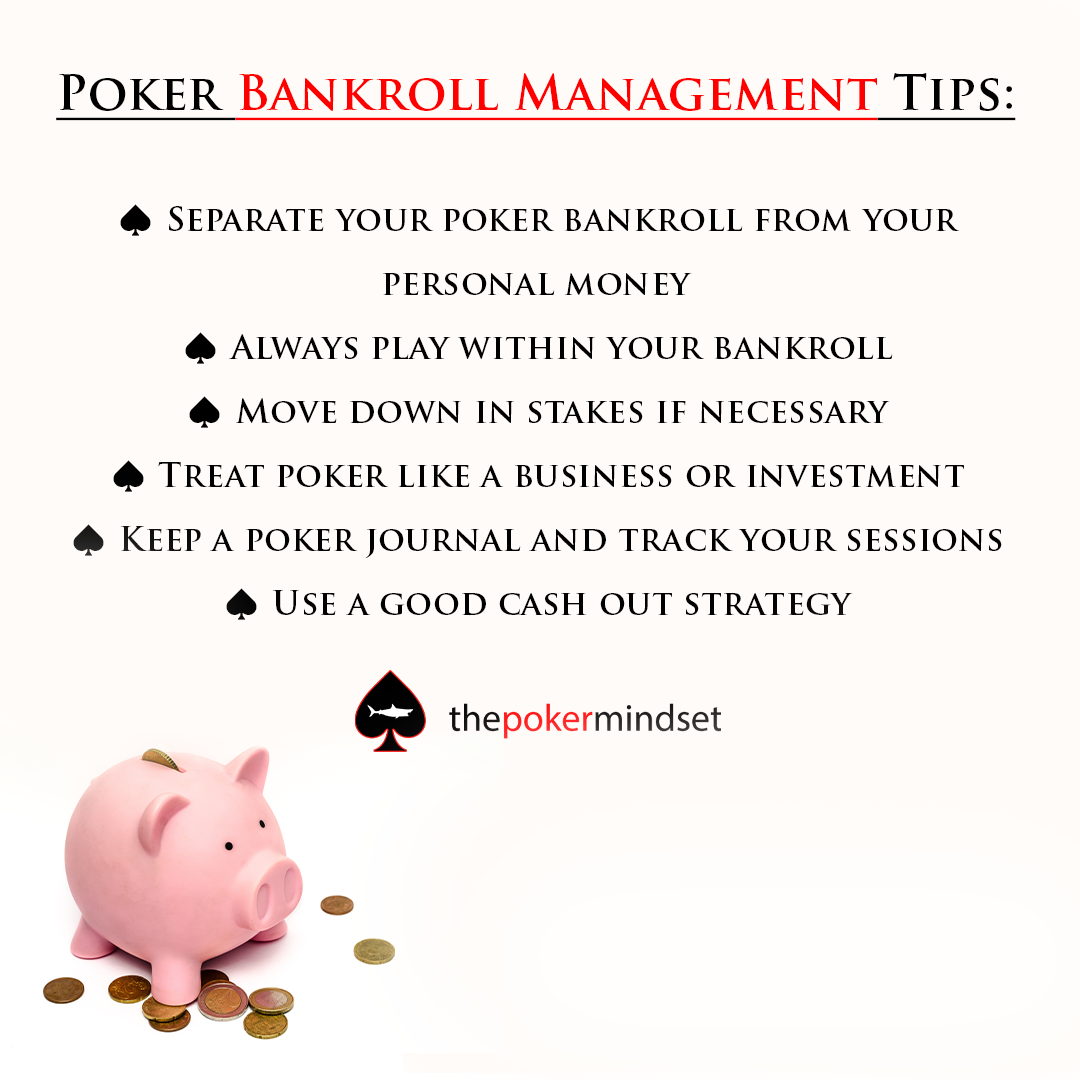
Good bankroll management is crucial for poker players. It is one of the most important parts of your overall strategy and is something you have control over. The number one reason a player goes broke is due to poor bankroll management.
Here are some poker bankroll management tips:
1. Separate your poker bankroll from your personal money
Think about poker as an investment or a company. Make sure you separate your bankroll from your personal money and avoid spending your poker money. Of course, if your only income is from poker you have to use a good cash out strategy and stick to it. Remember, just like in any business, money makes money.
2. Always play within your bankroll
Not playing within your bankroll is the most common mistake poker players make, which leads to going broke. Set yourself strict bankroll management rules and do not deviate from them no matter what! After losing a couple of pots you might be tempted to move up and win the money back quickly, this often makes things worse. Shift your perspective from money-oriented to process-oriented.
Keep in mind that no matter how soft a higher stake game is or how big a higher buy-in tournament is, if your bankroll doesn’t allow it be smart and don’t play there.
3. Move down in stakes if necessary
A lot of players go broke, because of not moving down in stakes if necessary. It may feel bad, embarrassing or time-wasting, but you should feel good about making this decision. Put your ego aside and play for less money! Playing lower stakes can also help you to regain your confidence.
4. Treat poker like a business or investment
When choosing the right amount of money to play poker with, you have to think in the same way as you would when you invest in the stock market or in a business. If you want to be successful you have to be strict in the amount you choose to invest. The assumption that you can continually reload no matter what is a sure way to failure. Make sure you find the right amount to risk and stick to it, this way you will be disciplined and play your best poker.
5. Keep a poker journal and track your sessions
One of the best decision I made through my poker career was to start a poker journal. This way you will be able to clearly write down your goals and keep track of them. You will identify which games you perform better in, what leaks do you have and which parts of your game need more work. There are also many application and software to help you track your poker journey. For example: PokerTracker 4, Holdem Manager 2 and Hand2Note for online players; Poker Charts, Poker Dominator, My Poker Bankroll and Poker Bankroll Tracker for live players.
6 Use a good cash out strategy
If you want to constantly grow your bankroll make sure you set clear and strict cash out rules. Otherwise you will always spend your poker winnings on things you don’t necessarily need and you will never be able to take a shot at the next limit.
Poker Tournament Strategy And Tips
Everyday players are sitting down at the tables and consistently making fundamental mistakes because of lack of knowledge, misinformation or failing to maintain focus.
Even just a small strategical adjustment in poker can potentially save you a huge amount in the long run.
In this article we will point out some of the best live and online poker tournament strategy tips you can use to improve your game as quickly as possible.
Tip 1: Play The Right Starting Hands
Whether it be lack of patience, or an unfamiliarity with opening ranges, many tournament poker players still open too wide. This is especially true when it comes to early and middle position opens, where there are still many opponents left to act behind who can be dealt a strong hand.
The problem is when called, wide openers are often at a range disadvantage. Often being dominated by their opponents, they are vulnerable to 3 bets since they frequently won't have a holding strong enough to continue under pressure.
Furthermore, although opening a hand like 7 ♠ 5♠ might at times not be a terrible strategy from early or middle position, speculative hands like suited connectors and gappers, as well as small pairs, work best with deep stacks behind.
These speculative hand types infrequently connect strongly with the flop, so those times they do you want to have deep stakes behind to have the potential to win a huge pot. Modern day tournament structures often only see deep stack play occur during the first few levels of play. This leads us into the next tournament poker tip, being stack size aware.
Learn which hands to open raise in MTT's - Watch lesson 6.1 from the Road to Success MTT Course. A power-packed 50 minute video below, just use one of the button options to unlock it and get instant access.
Tip 2: Be Stack Size Aware
Effective stack size plays a critical role in a tournament players success.
Having a deep stack, and therefore expanding an opening range to include a lot of speculative suited hands and small pairs is a tournament strategy that is going to be punished if a number of short stacks are yet to act behind. This most notably occurs in turbo tournaments where the average stack size is quite short.
Short stacks will be in push-or-fold mode. Being short, they don't have time to wait and will be looking to take any opportunity they can to move all-in. This high rate of all-ins will leave wide openers frequently being forced to relinquish their hands, without even having the opportunity to try to hit a nice flop. Problematic hands often include; J8s , KTo and weak Ax hands.

It's not just short-stacks that can cause a problem, aggressive players will be looking to attack wide-openers. This is especially true when a player opens with a vulnerable M8-M14 (20bb-35bb) stack. 3 bets get good leverage against this stack size, since continuing in the pot represents committing a significant portion of a players stack.
Wide openers would be wise not to commit a large percentage of their stack with marginal holdings, and so will be forced to fold, or face being in a high-risk situation. Staying aware of your own stacks utility, as well as anticipating how opponents will utilize their stacks, is an important tournament poker tip to keep in mind.
POKER TIP: If you are currently using BB to calculate stack size, here's a look at why using 'M' is a better MTT strategy.
Tip 3: Be Careful Overplaying In The Early Stages
As a stack gets deeper, the less willing a competent player will be to put their entire stack at risk since they have more to lose. It's rare to see good players all-in during the early stages of a tournament with hands like AKo or JJ preflop.
Smart players recognize that their counterparts aren't going to be risking their entire stack with weaker hands like AQo . Therefore, even a strong hand like AK could be at a significant equity disadvantage facing a deep stacked opponents all-in range. Could you fold QQ here?
Rather than putting in an extra raise, often times just calling with even very strong hands in the early stage of a poker tournament has great benefits.
- Allows your opponents to continue with hands they were folding to a re-raise that you have crushed.
- Disguises the strength of your hand and keeps you unpredictable.
- Prevents you from getting all-in facing a super strong range where often times you're crushed.
Tip 4: Continuation Bet Aggressively But Not Always
Players have learnt the value of c-betting, but it's a strategy that is often misapplied. Being the preflop aggressor shouldn't lead to a mandatory c-bet and double barrels.
This is especially true in multi-way pots yet players continue to make fruitless c-bets with weak holdings into multiple opponents.
Even in heads-up situations, key factors to consider include;
- How does the flop texture interact with players ranges?
- Who has the strongest range?
- Who has nut advantage (the biggest share of super strong hands)?
- How passive or aggressive is the opponent we're facing?
- How does the stack size/SPR allow us to operate on the flop and future streets?
The following hand illustrates the effect nut advantage can have on profitable continuation betting and how it applies to this tournament poker tip:
Tip 5: Be ICM Aware
The Independent Chip Model or ICM, is a great model players use to make more profitable decisions when deep in a tournament and especially at a final table.
Unlike in cash games, chip values fluctuate depending on the stage of the tournament and the competing opponents stack sizes. At it's most extreme, ICM strategy can make A♠A♣: an easy fold preflop.
Imagine a situation in a satellite where 9 players get a World Series of Poker entry and there's 10 remaining. The action folds around to a player with 100,000 in tournament chips who moves all in from the small blind. You're sitting in the big blind with A♠A♣: and also 100,000 in chips. You look around and see a few opponents with only 1000 chips left, which is the size of the current big blind. Obviously one of these short stacks is likely to bust very soon.
Obviously one of these short stacks is likely to bust very soon. Moreover the chance that they collectively out survive your 100,000 stack is extremely remote. You'd likely be a 99% chance to get a WSOP entry, so why would you call with your A♠A♣ and risk busting next around 20% of the time?
Aside from calling too wide in spots when the most profitable strategy is to proceed tightly, the opposite can also be true when it comes to pressuring your opponents. ICM allows players when they have the opportunity to assert pressure on there opponents stacks, to go ahead and do so liberally, since thinking opponents counter-strategy is to play a tight range of hands.
Here's an example of how drastically a hand range can change when the opportunity to assert pressure at a final table exists. 5 of the 6 remaining players at the Pokerstars Sunday Millions have 15bb's, whilst the UTG player has a short 2bb stack. Since the 15bb stacks wants to avoid busting out next and missing out on a large pay jump before the immanent bust out of the 2bb stack, the small blind can adjust their all-in range. Instead of the profitably 57% all-in range in normal play, they can move all-in with 100% of hands to apply pressure on the big blind.

Whilst the big blind should adjust their calling range from the regular 36% to just 10% of hands to account for the ICM effect in play.

The PokerNerve Road to Success course teaches players how to master ICM situations, which is key to tournament poker success since ICM comes into play as the prizes become significant. If there was only one tournament poker tip that you take away from this article, it's that you need to know ICM!
Tip 6: Bet The Appropriate Size
Strong players are capitalizing on their opponents tendencies to bet too big or too small in a number of different situations. With some similar considerations to that of continuation betting, when selecting a bet size important aspects include;
- Which player's range does the board texture favor?
- Who has the greatest nut saturation?
- How does SPR influence our betting strategy
There are many great articles online about bet sizing. You should be sure to check out ThePokerBank's and the Pokerology's to learn more about this tournament tip.
Free MTT Poker Training:
The Underused MTT Skills Essential For Success
- 5 Day Email MTT Poker Training Course By Poker Pro Kelvin "Acesup" Beattie
- 3 Key Skills That Will Take Your MTT Poker Game To A New Level
- 1.5 Hours Of Professional Poker Training

Tip 7: Take Equity Realization Into Account

Possibly due to the popularity growth of Twitch, many poker players approach to big blind play has evolved. The current trend is to defend the big blind with virtually any 2 cards, as some top pros elect to do, and the justification for this is taking advantage of the excellent pot odds being offered.
While the inclusion of antes combined with commonly seeing a small open raise size does offer the big blind generous pot odds, this has led to a fundamental flaw in the way many players approach big blind play in poker tournaments. The key concept overlooked, is equity realization.
Equity realization reflects a players ability to take a certain hand, and win their share of the pot, frequently enough, to make it profitable in the long-term. Although some top pros have the ability to win their equity share of the pot even out of position, less skilled players rarely do. This leads to a large chip loss in the long run.
It is quite difficult to realize of your equity when out of position, with no initiative and a weak range. This means them glorious odds you are being offered aren't quite as good as you think!
The following article explains this crucial tournament poker tip in more detail; Equity Realization.
Tip 8: Don't Miss Double And Triple Barrel Opportunities
'One and done' is the plight of many aspiring tournament poker players. Everyday at the tables I see players missing profitable opportunities to double, or even triple barrel. Understanding what turn and river cards are advantageous to a players range, along with opponent tendencies, are crucial parts of a winning barreling formula.
The most common scenario at the table, is a heads-up pot where the big blind calls an open-raise. And this happens to be a great spot to barrel. Big blind defenders have a wide range, and it's important to pressure this wide range, especially on only partially connected board textures with one or multiple high cards.

RedChipPoker has a great article on spotting profitable double barrel opportunities which you can read here: THE +EV DOUBLE BARREL GUIDE
Tip 9: Check-Raise More Flops
The biggest difference between the current tournament population, and the future generation, will likely be their approach to check-raising the flop. This opportunity typically occurs in a heads-up pot, after defending the big blind verse an opponents raise.
Currently, MTT players only check-raise the flop in this situation around 7-8% of the time, when closer to 20% is a more optimal strategy. On certain flop textures, check-raising close to 25% of the time is an extremely profitable strategy. And if players are getting out of line with their c-bets, then check-raising at an even higher frequency could be a profitable exploit.
By giving up too easily on a wide range of board textures, or taking a more passive approach and simply calling, c-betting can be done with reckless abandon. However, by selecting a nice mix of check-raising hands, combining some strong hands with some good semi-bluffing candidates, a check-raiser can become tricky to play against and exploit the average players tendency to over c-bet.
POKER TIP: Applied correctly and check-raising becomes a super powerful weapon in your arsenal leading to more profitable poker results. But also think beyond the flop, there's plenty of check-raising opportunities you may be missing. This video demonstrates an interesting turn check-raise situation.
We discuss check raising strategy in more detail in our post over on unfeltedpoker.com.
Tip 10: Develop A Good 3betting Strategy
Whilst 3 betting aggressively is a strategy many players employ, especially in online poker circles, failure to apply optimal 3 betting strategies has certainly led to a lot of spewy poker. Simply attacking opponents who are suspected of opening wide doesn't cut it in the modern poker world.

Players have learnt to deal with 3 bets more profitably, by mixing in some calls with timely 4 bets. Moreover, the role stack size plays when it comes to 3 betting it still largely misunderstood by much of the poker community.
Sure there are certain stack sizes where 3 bets gain a lot of leverage, but how about the role blockers play? And when is 9 ♦ 7 ♦ a better 3 bet candidate than K ♦ T♠ ? These are just some of the considerations when it comes to a profitable 3 betting strategy. See how to design strong 3betting ranges in this article by Donkr.
Bonus Poker Strategy Tip: Avoid and Deal with Downswings
As a poker player you want to earn your money as easily and as stress-free as possible right? Well, understanding ROI, variance and bankroll management can help (see TopPokerValue's article on bankroll management).
All poker players at some point experience downswings. In some cases, this can affect their play, volume or state of mind.
You'll be miserable, hating poker, playing less and earning less per tournament as your play will suffer.
Along with finding ways that work for you to keep a positive mindset, taking pro-active steps can help keep you confident by knowing you are dealing with the situation like a professional whilst at the same time taking positive action to get back on track and winning.

What is ROI and variance?
Every tournament you enter has an EV associated with it. So if you enter a $10 tourney, as a good player maybe you have a 30% ROI, so you make $3. So it doesn't matter whether you brick that tourney or win it for $5000, you make $3 in the long run.
Now, of course, you don't make $3 each time. 80-85% of the time you lose that $10, some percentage of the time you win a little bit, and some very small percentage of the time you win a lot. How small those ‘small percentages’ are primarily depends on not only your skill edge, but also the field size which is an extremely important concept that is often ignored.
Variance is a factor of two things:
You play the Hot $55 which has $30K guaranteed, every day for a year on Pokerstars. It has 1600 runners and you have a 5% ROI, because turbo ROIs are small. Your average yearly profit is $605 however you will lose money on the year 55% of the time.
You play a $20 tourney with $3K guaranteed on a softer site every day for a year. It has 200 runners and you have a 30% ROI, because it's a normal speed tourney and you’re against an easier field. Your average yearly profit is $2400 and in this case you lose money only 12% of the time.
A lot of people would look at those two tournaments and make a decision based on the buy-in and 1st place prize money as to which was better to play, and it would be grossly wrong. Once you accept all the above, you realise that the 'up top' number is largely meaningless.
Yes, on the same site bigger fields may mean a lot of fish have registered to play, but you'll find a lot of small field, soft, non-peak hour tournaments have a great pro-to-fish ratio and hence are great value. Of course once you consider other sites that have smaller fields, you'll often find they are a better choice than what might be running on Pokerstars.
So what can you do?
When players start losing money and along with that, confidence, not only does their game deteriorate but they often compound that problem by failing to make rational decisions. Often losing players, or players on a downswing, go "bink chasing" and decide to take a shot to win all their money back in one tourney. Or load up some quick $82 hyper-turbos to try to turn it all around quickly.
People get overly fixated on what's 'up top' and wanting to score big in one tournament. That’s a sure-fire strategy to fuel a down swing. If your house got knocked down would you try to slap it back up in a week? Take that opportunity to rebuild a better, stronger house.
Make sure you're adding in some study and keep focused (see Sky's Matsuhashi How To Study Poker series), and stay fresh and positive as you approach each session. Be smart and get back into profit quicker instead of enduring a 6-12 month variance rollercoaster!
Closing Words On Tournament Poker Tips
Poker is a multi-faceted game which makes it fun but challenging. Challenge yourself to factor in the relevant concepts, and make more profitable decisions. Tighten up from the big blind, and in general around the table. This tip often quickly improves a new players results, or those that have a got a little sloppy with their play.
Calculate stack size using 'M'. Always be aware of your own, and your opponents stack sizes so you don't get yourself caught in awkward situations. One awkward situation that often comes up is when you hold an overpair to the board and an opponent puts the heat on you. Don't be afraid to make big lay downs to preserve your stack, especially in the early levels.
Be aware of your cbetting frequency. There's no need to waste tournament poker chips cbetting every time, especially when the pot is multi-way. Pick your spots to make profitable plays. Remember when it comes to the final table, regularly profitable playing ranges might alter due to the payouts. ICM is the key when it comes to those final big decisions.
Another key to success is knowing when to fire multiple bullets at your opponents. Barreling, especially against a wide big blind range can really help increase your non-showdown winnings. Finding ways to accumulate chips without always having the best hand is what top players do. This is why check-raising and having a good 3 betting strategy is so important. Correct use of these strategical concepts and the other tips outlines will get you winning more at the tables.
Now that you've acquired some great holdem tournament strategy tips to help you achieve MTT success, go out there an implement them!
One of the quickest way to improve your poker game is to take on a poker coaching, a course or join a poker training site; if that is something that interests you be sure to check out the PokerNerve road to Success Course for some advanced poker tournament strategy or you can check out HowToPlayPokerInfo's guide on poker training & poker courses to find the right option for you.

Any other poker tournament strategy tips? Leave them below in the comments, we would love to hear them!
So, let's define, what was the most valuable conclusion of this review: Having poker bankroll management (BRM) is one of the keys to be a successful poker player. Learn how to build yours using bankroll management charts. at Top 10 Tips for Online Poker Bankroll Management in Canada
Contents of the article
- Top Tips for Building Poker Bankroll...
- Matthew Cluff
- Understanding Bankroll Buy-In...
- Reassessing Bankroll Management...
- Shot Taking: Moving Up...
- Shot Taking: A Psychological...
- How Much Do You Need To Go...
- BRM: Tournament Bankroll...
- In Conclusion – Poker Bankroll...
- Top 7 Tips for Creating and Maintaining...
- Are You Playing any of the Top 7 Worst...
- Striking that Delicate Balance with...
- Open-Face Chinese Poker Is the New...
- Quack! Quack! Learn How to Turn Pocket...
- A Comprehensive Guide to Bankroll...
- Bankroll Management Explained
- Bonuses and Your Bankroll
- The Ideal Starting Bankroll
- How Much to Risk
- at least 20 buy-ins
- Example: .05-.10NL
- to win twice the buy-in
- limit of no more than two buy-ins per...
- restrict yourself to 2% of your...
- 1. The Stakes
- 2. The Game Type
- 3. The Rate of Winning
- 4. The Comfort Level
- Examples of Bankroll Building
- Player A
- live 200 NL
- hourly rate of $12
- bankroll up to $5,000
- jump to $2/$5
- Player B
- over 25,000 tournaments
- 25% average return on investment
- lowering average buy-in to 250
- extra 50 buy-ins to plan shots carefully
- Player C
- 30,000 super turbos
- 5% return on investment
- ready to play a new game type
- Managing Your Expectations
- How to Avoid Losing Your Bankroll
- Avoid re-buy tournaments
- Watch out for late registration
- Get there early
- Forget the auto-top up option
- Six Tips for Managing Your Poker...
- 1. Separate your personal and poker...
- 2. Always play within your bankroll
- 3. Avoid desperate moves to "stop"...
- 4. Move down in stakes when necessary
- 5. Keep track of your sessions
- 6. Save money on "poker expenses"
- Conclusion
- Poker Bankroll Management Tips
- 1. Separate your poker bankroll from...
- 2. Always play within your bankroll
- 3. Move down in stakes if necessary
- 4. Treat poker like a business or...
- 5. Keep a poker journal and track your...
- 6 Use a good cash out strategy
- Poker Tournament Strategy And Tips
- Tip 1: Play The Right Starting...
- Tip 2: Be Stack Size...
- Tip 3: Be...
- Tip 4:...
- Tip 5: Be ICM...
- Tip 6: Bet The...
- Tip 7: Take Equity...
- Tip 8: Don't...
- Tip 9:...
- Tip 10:...
- Bonus Poker Strategy...
- Closing Words On Tournament...
No comments:
Post a Comment
Note: Only a member of this blog may post a comment.